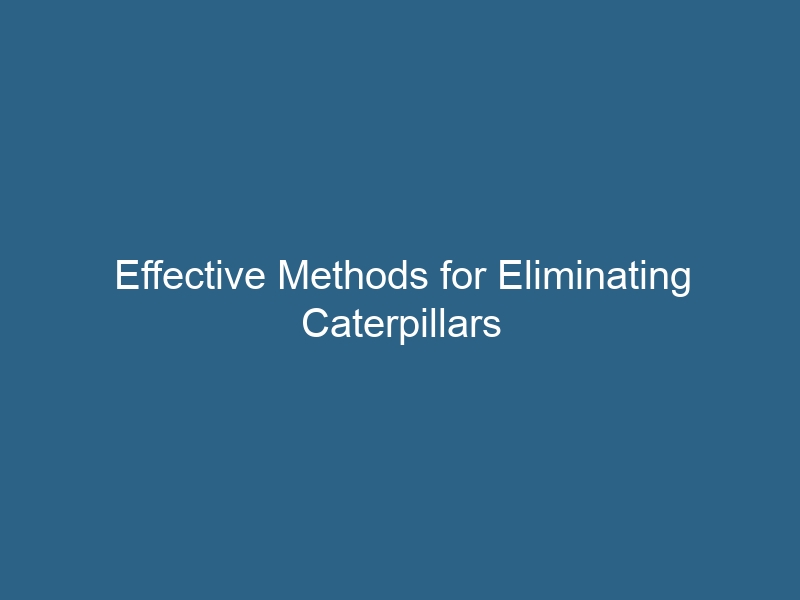Quck answer
Caterpillars can be killed using various methods. One option is to manually remove them from the plants and squash them. Another method is to use insecticides specifically designed to target caterpillars. These can be applied directly to the affected plants. Biological control can also be effective, such as introducing natural predators like birds or beneficial insects. Additionally, using physical barriers like nets or sticky traps can prevent caterpillars from reaching the plants. It is important to identify the exact species of caterpillar and choose the appropriate method for control, as some caterpillars may be beneficial or protected.
Garden caterpillars may appear harmless due to their small size and attractive appearance. However, these creatures can cause extensive damage to your plants by feeding on their leaves, shoots, flowers, and fruit. Fortunately, you can effectively manage this situation without resorting to harmful chemicals.
One option is to take no action if the infestation is minimal and the damage is minimal. Healthy adult plants can endure some leaf damage without significant consequences. However, if the infestation is severe or the plants are young or unhealthy, intervention may be necessary.
Strategies for Control
Caterpillars have a voracious appetite and feed exclusively on plants. Differentiating between beneficial caterpillars, which develop into desirable butterflies and moths, and harmful ones is crucial. Therefore, it is important to familiarize yourself with the larvae of various moths and butterflies before resorting to eradication measures.
When intervention is required, manually removing caterpillars, using non-toxic pest control products, and encouraging natural predators are effective approaches. Employing an integrated, non-toxic management plan ensures safety for you, your pets, and the environment.
Monitoring Caterpillar Activity
Early detection is key to preventing extensive damage caused by caterpillars. Regularly inspect your plants for signs of infestation, such as caterpillars, eggs, feces, and webbed or skeletonized leaves. Rolled leaves are particularly suspicious and likely to harbor caterpillars.
Manual Pest Control
Prepare a bucket of soapy water and don gardening gloves, if desired. Thoroughly examine each plant, paying attention to the undersides of leaves and petioles, where pests often hide. Remove any webbed or rolled leaves or stems and dispose of them in a plastic bag, not in your compost. When you encounter a caterpillar, pluck it from the plant and either squash it or drop it into the soapy water to drown.
Environmentally Friendly Pesticides and Predators that Attack Aggressively
If small caterpillars continue to appear despite your best efforts to control them manually, it is strong evidence of breeding activity. In this case, you may need to use more aggressive (but still non-toxic) techniques to manage them. Low-impact pesticides degrade quickly after being applied, causing minimal damage and little to no impact on bees, natural enemies, and pollinators:
-
Insecticidal soap needs to come into direct contact with the pest in order to be effective. So, generously spray the caterpillars with it. It works best when the pests are still young. Insecticidal soap has little to no negative effects on beneficial insects.
-
Neem oil, made from the extract of neem tree seeds, is highly effective in killing various insect pests, including caterpillars. This substance works best on creatures that have not yet reached their full size. Neem oil needs to cover the caterpillar to kill it, but it is safe for beneficial insects and pollinators once it has dried.
-
Bacillus thuringiensis var. kurstaki (Btk) is a strain of Bt that specifically targets and kills caterpillars. It is a bacterium that naturally occurs in soil. Apply it generously on the plant’s leaves, as caterpillars need to ingest this substance for it to be lethal. Btk works best on young caterpillars and has no effect on other insects, including bees.
-
Spinosad is harmful to bees but poses less risk to other beneficial insects, mammals, birds, and fish compared to most insecticides. It is an effective weapon against caterpillars, primarily killing them through ingestion.
- Purchase parasitic wasps that specialize in parasitizing caterpillars (parasitics typically target a specific host species). This will reduce the need for handpicking. These non-stinging insects lay their eggs inside host caterpillars. The eggs hatch, and the larvae immediately start feeding on the host. Attract naturally occurring parasitic wasps or maintain your own by planting allium, zinnia, alyssum, yarrow, statice, cosmos, thyme, dill, lemon balm, and fennel.
- Attract natural predators of caterpillars to your property, such as birds and spiders. Similar to parasitic wasps, they will help reduce the need for handpicking. You can also purchase green lacewing eggs to release in your garden.
Tip
To minimize threats to bees and other pollinators, trim flowers off treated plants so that beneficial insects are not attracted to them. Limit your treatments to early morning or nighttime hours, as bees and pollinators only forage during daylight. This significantly reduces the risks to them.


